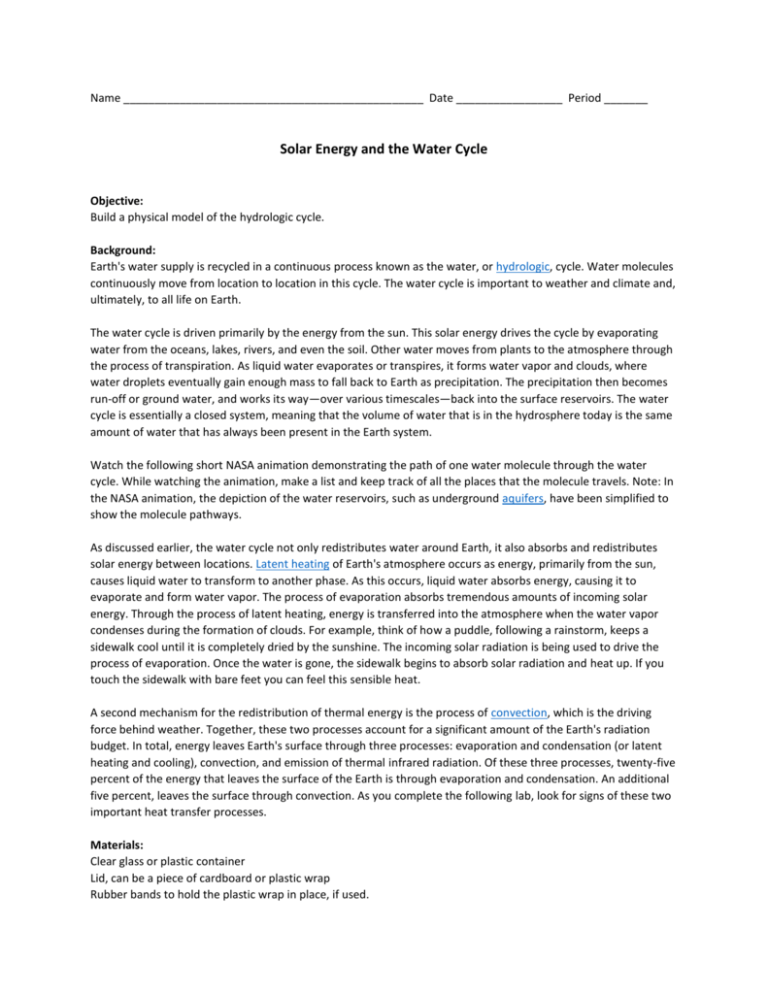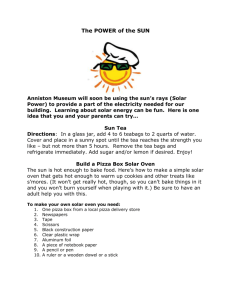Solar Energy and the Water Cycle
advertisement

Name ________________________________________________ Date _________________ Period _______ Solar Energy and the Water Cycle Objective: Build a physical model of the hydrologic cycle. Background: Earth's water supply is recycled in a continuous process known as the water, or hydrologic, cycle. Water molecules continuously move from location to location in this cycle. The water cycle is important to weather and climate and, ultimately, to all life on Earth. The water cycle is driven primarily by the energy from the sun. This solar energy drives the cycle by evaporating water from the oceans, lakes, rivers, and even the soil. Other water moves from plants to the atmosphere through the process of transpiration. As liquid water evaporates or transpires, it forms water vapor and clouds, where water droplets eventually gain enough mass to fall back to Earth as precipitation. The precipitation then becomes run-off or ground water, and works its way—over various timescales—back into the surface reservoirs. The water cycle is essentially a closed system, meaning that the volume of water that is in the hydrosphere today is the same amount of water that has always been present in the Earth system. Watch the following short NASA animation demonstrating the path of one water molecule through the water cycle. While watching the animation, make a list and keep track of all the places that the molecule travels. Note: In the NASA animation, the depiction of the water reservoirs, such as underground aquifers, have been simplified to show the molecule pathways. As discussed earlier, the water cycle not only redistributes water around Earth, it also absorbs and redistributes solar energy between locations. Latent heating of Earth's atmosphere occurs as energy, primarily from the sun, causes liquid water to transform to another phase. As this occurs, liquid water absorbs energy, causing it to evaporate and form water vapor. The process of evaporation absorbs tremendous amounts of incoming solar energy. Through the process of latent heating, energy is transferred into the atmosphere when the water vapor condenses during the formation of clouds. For example, think of how a puddle, following a rainstorm, keeps a sidewalk cool until it is completely dried by the sunshine. The incoming solar radiation is being used to drive the process of evaporation. Once the water is gone, the sidewalk begins to absorb solar radiation and heat up. If you touch the sidewalk with bare feet you can feel this sensible heat. A second mechanism for the redistribution of thermal energy is the process of convection, which is the driving force behind weather. Together, these two processes account for a significant amount of the Earth's radiation budget. In total, energy leaves Earth's surface through three processes: evaporation and condensation (or latent heating and cooling), convection, and emission of thermal infrared radiation. Of these three processes, twenty-five percent of the energy that leaves the surface of the Earth is through evaporation and condensation. An additional five percent, leaves the surface through convection. As you complete the following lab, look for signs of these two important heat transfer processes. Materials: Clear glass or plastic container Lid, can be a piece of cardboard or plastic wrap Rubber bands to hold the plastic wrap in place, if used. Ziplock bag filled with sand, gravel or soil Warm water Jar lid or small bowl Ice Small insulated cup or ziplock bag for ice Light source: bright sunlight or lamp (40-60W) Procedure: 1. Set up the equipment as show in the figure, right, or picture below. 2. 3. 4. 5. 6. 7. 8. If you are using plastic wrap, you can just place the ice in a baggie and put it directly on the plastic wrap cover. Add enough water to fill the container with water to a depth of 2-5 cm. Optional: Add several drops of food coloring to make it easier to see the water. Position a bag of sand or gravel at one end of the aquarium. The sand / gravel should be above the water level. Add a small jar lid or bowl to the "land area" on top of the sand and under the ice. Fill a ziplock bag with ice and place it on top of the plastic wrap. Place a focused lamp, such as a desk lamp, so that it heats the water at the other end of the aquarium or box. If the lid of the box is clear, shine the light through the lid; otherwise aim it at the water through the side of the aquarium. Turn on the lamp, or place the apparatus in the sun, and watch the water cycle occur. Analysis: Once you have produced your water cycle model, critique its effectiveness. 1. Which parts of the water cycle were clearly demonstrated with this lab? 2. Which parts of the water cycle were not well demonstrated with this lab? 3. How might you document and share your demonstration with other students? 4. Draw a sketch of your water cycle model and add words to describe the processes taking place in the model. Conclusion: 1. Relate each part of your model to the water cycle. For example, the lamp represented the sun. What other Earth system processes were demonstrated in this lab? 2. What was the energy source for the water cycle? 3. How does the water cycle "transport" energy? 4. What do you think would happen if you added a second or even third lamp? 5. Describe what you think would happen if you left the water cycle in a shoebox in the dark for several hours.








